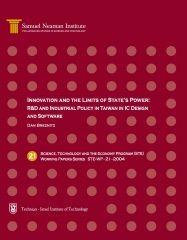Of the East Asian Newly Industrialized Countries (NIC) Taiwan story is one of the most inspiring. In almost all accounts of Taiwan, the state has been described as the major impetus of economic development and technological upgrading. The Taiwanese government policy goal in the last decade has been to spur more new-products innovation capabilities.
This paper explores the capabilities and limits of the Taiwanese state in achieving such objectives in two key sectors of the IT industry, software and IC design. This is done through mapping of the evolution of, and the changing roles of the state in, these two subsectors, looking specifically at capabilities, innovations, and business models employed by private firms.
The main arguments are, first, the division of labor between state and private industry that successfully developed an industrial system utilizing OEM and ODM business strategies may now limit innovational capacity to second-generation innovations. Second, I argue that the public research institution-based industrial technology policy of Taiwan has been helping the growth of private industry when: (1) these research institutions created and expanded multiple and broad interactions with the private IT industry; (2) when the public research institute saw private IT firms as their final customers. On the other hand, the same policy approach has hampered the growth of the industry when the institute competed directly with the industry for its own customers.












